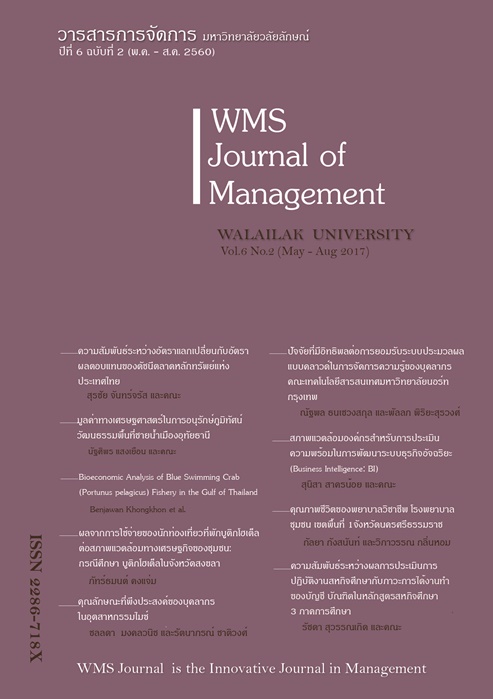The Relationship between Exchange Rate and Return of the Stock Exchange of Thailand
Main Article Content
Abstract
Article Details
References
ธนโชติ บุญวรโชติ และ มณฑินี ทองสิทธิ์, (2556). ความสัมพันธ์ระหว่างปริมาณการซื้อขายและอัตราผลตอบแทนในตลาดสินค้าเกษตรล่วงหน้า. ว. เกษตรศาสตร์ (สังคม), ปีที่ 34 : 77 – 91.
Abdalla, I., and Murinde, V. (1997). Exchange rate and Stock price interactions in emerging financial markets evidence on India,
Korea, Pakistan and The Philippines.Applied Financial Economics, 7(1), 1-35.
Barry, W.I. (2006). The Foreign Exchange Market. Econ 434 Fall 2006, 2-6.
Branson, W.H. (1983). Macroeconomic determinants of real exchange risk In Managing Foreign Exchange Risk. NBER Working Paper, 1335, 1-17.
Chen, J., Naylor, M., and Lu, X. (2004). Some insight into the foreign exchanges pricing puzzle: Evidence from a small open economy. Pacific-Basin Finance Journal, 12, 41-64.
Chiang, T.C., Yang, S.Y., Wang, T.S., (2000). Stock return and exchange rate risk: evidence from Asian stock markets based on a bivariate GARCH model. International Journal of Business 5, 97-117.
Chkili, W., Nguyen, D.K., (2014). Exchange rate movements and stock market returns in a regime switching environment: Evidence for BRICS countries. Research in International Business and Finance, 31, 46-56.
Choi, D.FS., Fang, V., and Young Fu, T. (2009). Volatility Spoilers between New Zealand Stock Market Return and Exchange Rate Change before and after the 1997 Asian Financial Crisis. Asian Journal of Finance and Accounting, 1(2), 106-113.
Dornbusch, R., and Fischer, S. (1980). Exchange rates and Current Account. The American Economic Review, 70(5), 96-97.
Foscolo, E. (2010). Analysis of Financial Time Series with EViews. EView7 User’s Guide II, Quantitative Micro Software, LLC, April 2, 209.
Gagnon, J.E., and Jan, I. (2004). Monetary Policy and Exchange Rate Pass-Through. International Journal of finance and Economics, 9, 315-338.
Garber, P.M. (1993). The Collapse of the Bretton Woods Fixed Exchange Rate System. The National Bureau of Economic Research, 461-494.
Gyntelberg, J., Loretan, M., and Subhanij, T. (2012). Exchange Rate Fluctuations and International Portfolio Rebalancing in Thailand. International Monetary Fun, 3-16.
Kwon, C.S., Shin, T.S., (1999). Cointegration and causality between macroeconomic variables and stock market returns. Global Finance Journal 10, 71-81.
Martin, A.W. (2014). International Monetary Fund:
Background and Issues for Congress. Congressional Research Service, 1-21.
Michael, D.D., and Barry, E. (1993). The Bretton Woods International Monetary System: A Historical overview. The National Bureau of Economic Research, 3-58.
Sekm S.O., and Ismali, M. (2012). Investigating the relationship between exchange rate and inflation targeting. Applied mathematical Sciences, 6(12), 1571-1583.
Tai, C.S., (2007). Market integration and contagion: Evidence from Asian emerging stock and foreign exchange markets. Emerging Markets Review, 8, 264-283.
Ulah Bhat, K., and Ali Shan, S.Z. (2015). Empirical investigation of the relationship between exchange rate movements and Stock market volatility in the context of Pakistan. Pakistan Business Review Jan, 744-74.
Wu, Y., (2000). Stock prices and exchange rates in VEC model-the case of Singapore in the 1990s. Journal of Economics and Finance, 24, 260-274.


